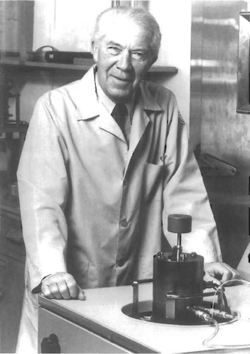De Duve, Christian (1917-2013)
Cell biologist and Nobel Prize winner, born on 2 October 1917 in Thames Ditton, Great Britain and died on 4 May 2013 in Antwerp.
Biography
Christian de Duve was born in Thames Ditton to Belgian parents, who had fled to Great Britain during the First World War. In 1920, the family returned to Antwerp, their home city. Son Christian embarked on a course in medicine at the University of Leuven in 1934. In 1941, he graduated as a Doctor of Medicine. Afterwards he did research on the effect of insulin on the absorption of glucose in the laboratory of P.J Bouckaert. He underwent additional training in chemistry so he could also approach his research from a biochemical angle. He combined his chemistry degree with an internship at the Cancer Institute in Leuven.
In 1945 he presented a thesis entitled Glucose, Insulin et Diabète [Glucose, Insulin, and Diabetes]. A year later, he obtained the title of licentiate (now called a master’s degree) in chemistry. After the Second World War he worked at the Medical Nobel Institute in Stockholm (Sweden) for one and a half years. This was followed by a half-year stay at the University of Washington (United States). In 1947, he returned to the University of Leuven as lecturer in physiological chemistry and as a researcher. In addition, he set up a small laboratory in Leuven, which focused on insulin and glucagon research. In 1951, he became a professor. From 1962 onwards, he also lectured and did research at the Rockefeller University in New York. Here, he set up a second research group, which collaborated closely with the research group in Leuven. In 1974, de Duve founded the International Institute of Cellular and Molecular Pathology (ICP, which is now called De Duve Institute) in Brussels. He also became its first president.
De Duve’s research on cellular structures fueled new insights in the fields of biochemistry and genetics. He, for example, discovered lysosomes and peroxisomes, which he described in 1955 and 1965 respectively. He discovered these cell organelles by developing a new research method, which combined ultracentrifuge techniques with biochemical instruments. He also continued to do research on insulin and glucagon. In the twilight of his career, he studied the origins and evolution of life. The three books which he wrote on this theme were translated into several languages.
De Duve won the Francqui Prize in 1960. In 1974, Albert Claude, George Emil Palade, and de Duve were awarded the Nobel Prize in Medicine for describing the structure and function of organelles in biological cells. De Duve was a member of the Royal Academy of Medicine of Belgium and of numerous foreign academies. In 1990, he received the cherry on the cake: the title of viscount.[1]
Bibliography
- Thiefry, Denis, “De Fundamentele biologie: van het organisme tot de cel, van de molecule tot het ecosysteem”, in: Robert Halleux, Geert Vanpaemel, Jan Vandersmissen en Andrée Despy-Meyer (red.), Geschiedenis van de wetenschappen in België 1815-2000, Brussel: Dexia, 2001, vol. 2, 206-207.
- “Autobiography”, on Nobelprize.org.
- A tribute to Professor de Duve on the website of the de Duve-instituut.
- Hommage au Professeur de Duve on the website of the de Duve-instituut.
